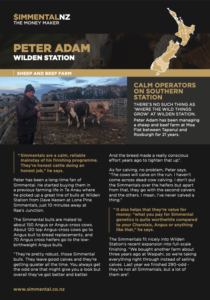Resources
Case study
PETER ADAM
WILDEN STATION, SOUTH OTAGO
BACKGROUND
- Sheep and beef farm
- Peter Adam has been managing a sheep and beef farm at Moa Flat between Tapanui and Roxburgh for 21 years
- The Simmental bulls are mated to about 150 Angus or Angus-cross cows. About 120 top Angus-cross cows go to Angus bull to breed replacements, and 70 Angus cross heifers go to the low-birthweight Angus bulls

SIMMENTAL
INVOLVEMENT
THERE’S NO SUCH THING AS ‘WHERE THE WILD THINGS GROW’ AT WILDEN STATION.
Simmentals are a calm, reliable mainstay of his finishing programme. They’re honest cattle doing an honest job,” he says.
Peter has been a long-time fan of Simmental. He started buying them in a previous farming life in Te Anau where he picked up a great line of bulls at Wilden Station from Dave Keown at Lone Pine Simmentals, just 10 minutes away at Rae’s Junction.
The Simmental bulls are mated to about 150 Angus or Angus-cross cows. About 120 top Angus-cross cows go to Angus bull to breed replacements, and 70 Angus cross heifers go to the low-birthweight Angus bulls.
“They’re pretty robust, those Simmental bulls. They leave good calves and they’re getting quieter all the time. You always get the odd one that might give you a look but overall they’ve got better and better.
And the breed made a really conscious effort years ago to tighten that up”.
As for calving, no problem, Peter says. “The cows will calve on the run. I haven’t come across dead-cow calving. I don’t put the Simmentals over the heifers but apart from that, they go with the second calvers and the others. I mean, I’ve never calved a thing.”
“It also helps that they’re value for money: “what you pay for Simmental genetics is quite worthwhile compared to your Charolais, Angus or anything like that,” he says.
The Simmentals fit nicely into Wilden Station’s recent expansion into full-scale finishing. “We bought another farm about three years ago at Waipahi, so we’re taking everything right through instead of selling calves. Last year we finished 290-odd – they’re not all Simmentals, but a lot of them are”.
Download PDF
“Simmentals must be good because we keep going back to them.”
Peter believes the Simmentals must be good “because we keep going back to them. They’re good calves if you’re buying bulls with good arses, good feet and good temperament. Now we’re taking them through; they’re the sort of cattle that you can really take them to big weights if you want to”.
He also looks for growth-potential right from the moment the calf is born.
“They’ve got to be growing right through. We usually buy the top-end bulls for that, the ones with a higher EBV’s for 400 and 600-day weights”.
And using EBV’s supplied by the bull breeder is a useful tool in making those selection decisions.
The farm between Clinton and Gore also finishes lambs and created new opportunities all-round, Peter says.
“We winter all the terminal calves on fodder beet here [at Wilden] and we drip-feed them down to Waipahi in the spring. We previously sold at the Heriot calf sale for years but it’s quite cool to now be able to take them from the breeding right through to finishing”.
The grass-fed Wilden Station rises to about 640m at the back of the property, running down to the Pomahaka River. The cows spend all winter on five good blocks where they stay for calving.
The farm is owned by Hamilton-based John Maisey of the plastics manufacturer Maisey Group, which makes parts for drench guns, among other products. Peter works with three other staff, two at Wilden and a third at Waipahi.